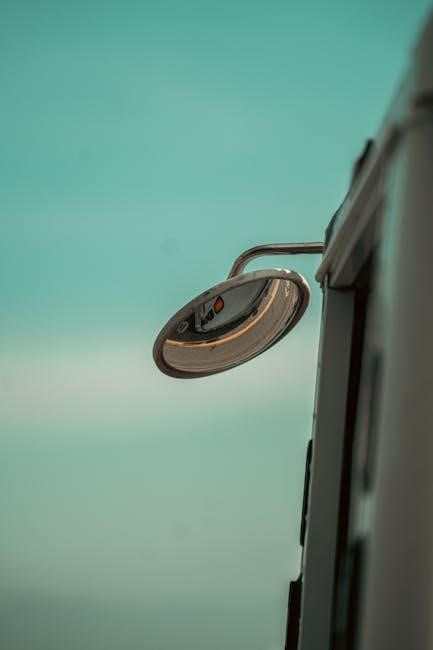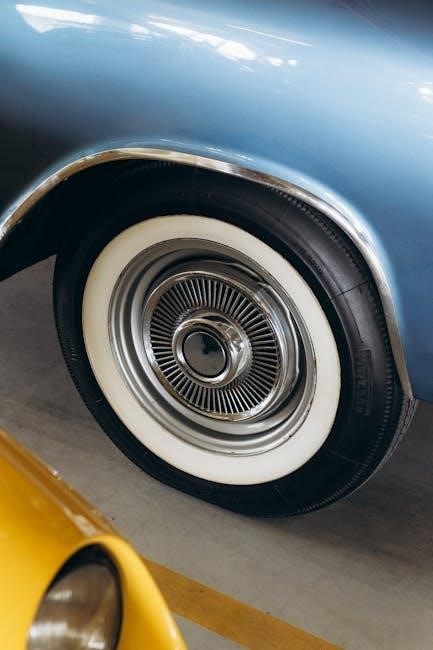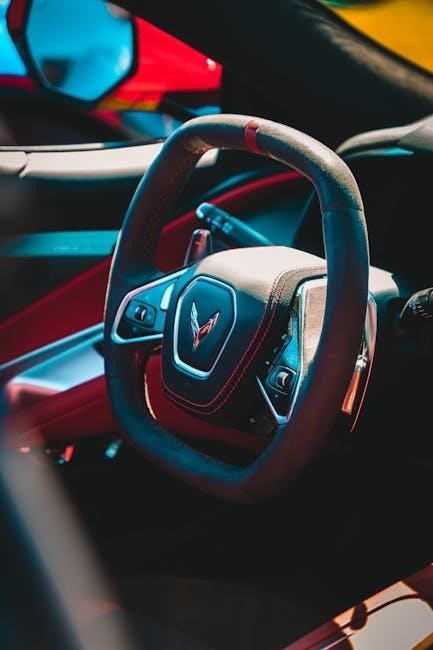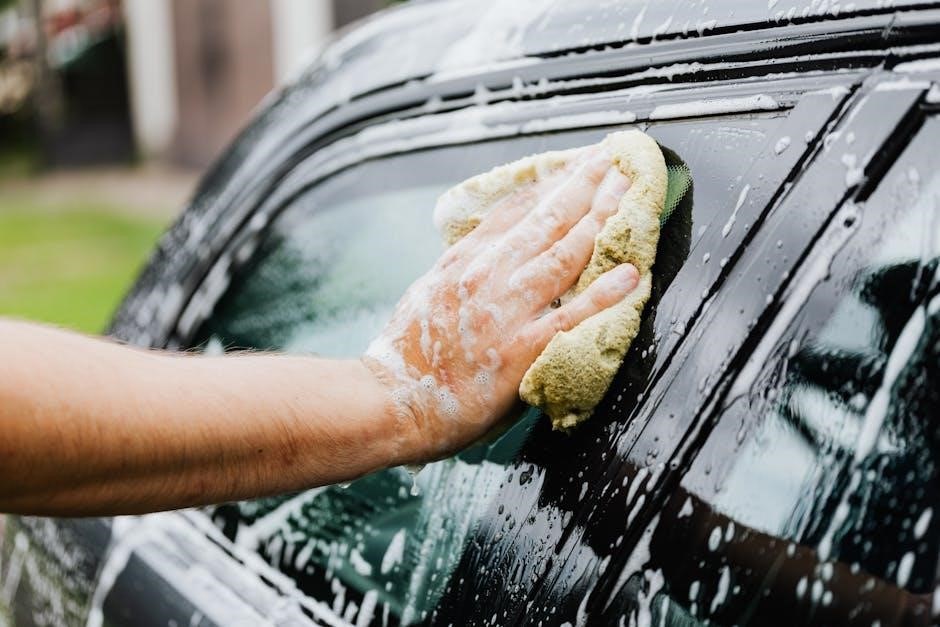Welcome to the Full HD 1080P Car DVR user manual. This guide provides detailed instructions for using your dash cam effectively, ensuring safe and high-quality video recording.
Learn about its key features, installation, and advanced functions to maximize your driving experience and vehicle security with this intuitive and powerful recording device.
1.1. Purpose of the User Manual
This manual guides users through the safe and effective use of the Full HD 1080P Car DVR. It explains installation, operation, and advanced features like motion detection and Wi-Fi connectivity. The manual ensures users understand how to configure settings, troubleshoot issues, and maintain the device for optimal performance. By following this guide, users can maximize their driving experience and vehicle security with clear, step-by-step instructions tailored to their needs.
1.2. Key Features of the Full HD 1080P Car DVR
The Full HD 1080P Car DVR offers crystal-clear video recording with a wide-angle lens, capturing every detail on the road. It features automatic start/stop recording, motion detection for surveillance, and loop recording for memory management. The device supports Wi-Fi connectivity, allowing users to view and download footage on their smartphones. Additional features include a rotating screen, parking mode, and night vision, ensuring comprehensive coverage and enhanced security for your vehicle.

Product Overview
The Full HD 1080P Car DVR combines sleek design with advanced functionality, offering high-quality video recording, intuitive controls, and essential features for reliable performance and enhanced safety.
2.1. Design and Physical Description
The Full HD 1080P Car DVR features a compact and lightweight design, making it easy to install and position in any vehicle. The device has a high-quality plastic exterior with a sleek, modern appearance. It includes a 3-inch LCD screen for clear video playback and intuitive menu navigation. The DVR is equipped with a wide-angle lens for capturing broad road scenes and supports both suction cup and adhesive mounts for secure attachment to the windshield. Its compact dimensions ensure minimal obstruction of the driver’s view, while the adjustable mounting bracket allows for flexible positioning. The DVR also features a built-in microphone for audio recording and includes HDMI and USB ports for connectivity. The overall design emphasizes portability, durability, and ease of use, making it a practical solution for everyday driving.
2.2. Buttons and Controls Explained
The Full HD 1080P Car DVR features a user-friendly interface with clearly labeled buttons for easy operation. The Power button turns the device on/off, while the Record button starts and stops video capture. Navigation buttons (Up, Down, OK, and Back) allow you to scroll through menus, select options, and return to previous screens. A dedicated Play button switches between recording and playback modes, enabling quick access to stored footage.
2.3. Connectivity Options (Wi-Fi, HDMI, etc.)
The Full HD 1080P Car DVR offers versatile connectivity options to enhance functionality. Built-in Wi-Fi enables wireless file transfers to smartphones or tablets via a dedicated app. An HDMI port allows for crystal-clear video playback on external displays. A USB port provides power supply and data transfer capabilities, while an AV-out connects to rearview monitors for real-time viewing. These features ensure seamless integration and convenience for users.
Installation and Setup
Mount the DVR on your windshield for optimal viewing. Connect it to your car’s power supply and ensure the memory card is properly inserted. Calibrate the device for accurate alignment.
3.1. Mounting the DVR in Your Vehicle
Mount the DVR on your windshield using the provided suction cup or adhesive bracket. Ensure it faces directly forward for an unobstructed view. Position it near the rearview mirror to minimize glare. Adjust the angle for optimal recording clarity. Secure the device firmly to prevent movement while driving. Use the included mounting accessories for stability. Test the device after installation to ensure proper alignment and visibility. Refer to the manufacturer’s guidelines for specific mounting recommendations.
3.2. Connecting to Power Supply
Connect the DVR to your vehicle’s power supply using the provided USB cable and car charger. Plug the USB cable into the DVR’s USB port and the other end into the car charger. Insert the charger into your car’s cigarette lighter or 12V power outlet. Ensure the connection is secure to avoid power interruptions. The DVR will automatically power on when the engine starts. For hardwiring, consult a professional to connect directly to your car’s electrical system. Always use the original accessories to avoid damage.
3.3. Initial Setup and Configuration
Insert a compatible memory card into the DVR. Power on the device and navigate to the menu using the buttons. Set the time and date, and select your preferred video quality and resolution. Enable features like time stamps or night vision if desired. Refer to the menu options for additional settings. Once configured, the DVR is ready to record. Ensure all settings align with your preferences before starting use.

Using the DVR
Learn how to operate the DVR, including starting and stopping recordings, reviewing footage, and navigating the menu for a seamless user experience.
4.1. Starting and Stopping Recordings
Press the power button to turn on the DVR. Recording starts automatically when power is supplied. To stop recording, press the record button or power button again. The device indicates recording status with LED lights or on-screen icons. Automatic start/stop with ignition is available. The DVR records in continuous loops, with each clip lasting 3-5 minutes by default. Use the provided controls for manual recording adjustments.
4.2. Playback and Reviewing Footage
To playback recordings, navigate to the “Playback” menu using the navigation buttons. Select the desired video file from the list, and press the OK button to start playback. Use the playback controls to pause, rewind, or fast-forward. The LCD screen displays the footage in high definition. You can also connect the DVR to a computer via USB or HDMI for larger screen viewing. Delete unwanted clips directly from the device during playback.
4.3. Navigating the On-Screen Menu
Navigate the on-screen menu using the DVR’s buttons. The Up and Down buttons scroll through menu options, while the OK button selects an item. The Back button returns to the previous screen. The menu is intuitive, with options like video settings, playback, and system info. Use the navigation buttons to adjust settings or access features. The LCD screen displays clear icons and text for easy navigation.

Advanced Features
Explore advanced features like motion detection, loop recording, and night vision. These enhance security and ensure continuous recording. Parking mode adds surveillance when parked quietly.
5.1. Motion Detection and Automatic Recording
The Full HD 1080P Car DVR features motion detection, automatically recording when movement is detected. This enhances security by capturing unexpected events. Enable or disable the feature via settings for tailored use. It ensures continuous surveillance, especially in parking mode, providing peace of mind. The device starts recording instantly upon detecting motion, making it ideal for monitoring your vehicle even when unattended. Adjust sensitivity levels to minimize false triggers and optimize storage usage effectively.
5.2. Parking Mode and Surveillance
Parking mode activates when the engine is off, providing 24/7 surveillance. The DVR automatically records video and snapshots upon detecting motion or impacts, ensuring your vehicle is protected. Time-lapse recording minimizes storage usage while maintaining continuous monitoring. Enable this feature for added security, capturing potential incidents even when you’re not present. It offers peace of mind, knowing your car is safeguarded with round-the-clock monitoring capabilities, ideal for long-term parking or high-risk areas.
5.3. Loop Recording and Memory Management
Loop recording automatically overwrites old files to free up storage space, ensuring continuous recording without running out of memory. Users can customize the length of each recording clip, balancing storage capacity with video quality. This feature is ideal for long drives, as it prevents memory card overload. Regularly formatting the memory card via the settings menu helps maintain optimal performance and prevents file corruption, ensuring smooth operation of the DVR.

Customizing Settings
Customize settings to optimize video quality, enhance user experience, and tailor functionality to your preferences, ensuring the DVR performs at its best in various driving conditions.
6.1. Adjusting Video Quality and Resolution
Adjust video quality and resolution to ensure crisp footage while managing storage. Select from resolutions like 1080p, 720p, or lower. Higher settings provide clearer videos but consume more memory. You can also adjust bitrate and frame rate for optimal performance. Access these settings via the on-screen menu under video settings. Experiment with configurations to balance quality and storage needs for your driving recordings.
6.2. Setting Up Time Stamps and Watermarks
Customize time stamps and watermarks to add essential details to your recordings. Enable time stamps to display the date, time, and location on your footage. Watermarks can include vehicle ID or logos for identification. Access these settings in the DVR menu under “Time Stamp” and “Watermark” options; Adjust font size and position to ensure clarity without obstructing the view. These features enhance video authenticity and organization for legal or personal use.
6.3. Configuring Exposure and Night Vision
Optimize your DVR’s exposure and night vision settings for clearer footage in various lighting conditions. Adjust exposure levels to balance brightness and reduce glare. Enable night vision mode to enhance low-light sensitivity, ensuring crisp recordings in the dark. Use Wide Dynamic Range (WDR) to capture details in both bright and dark areas. These settings can be found in the “Image Settings” menu, allowing you to customize your DVR for superior performance day and night.

Troubleshooting Common Issues
Troubleshoot common issues like no power, video not recording, or connectivity problems. Check connections, format the memory card, or reset the device. Consult the manual or contact support for assistance.
7.1. No Power or Device Not Turning On
If your Full HD 1080P Car DVR doesn’t power on, first check the power supply connections. Ensure the USB cable is securely plugged into both the DVR and the power source. Verify that the cigarette lighter adapter is functioning properly. If using a battery, charge it for at least 30 minutes. If issues persist, try using a different USB cable or power outlet. Reset the device by holding the power button for 10 seconds. If it still doesn’t turn on, contact customer support for further assistance.
7.2. Video Not Recording or Corrupted Files
If the DVR isn’t recording or files are corrupted, first ensure the memory card is properly formatted. Check if the card is full or damaged. Restart the device and ensure it has sufficient storage. Verify that the recording settings, such as resolution and frame rate, are correctly configured. If issues persist, reformat the memory card using the device or a computer. Ensure the device is updated with the latest firmware for optimal performance.
7.3. Connectivity Problems (Wi-Fi, etc.)
If experiencing connectivity issues with Wi-Fi or other features, first restart the DVR and your smartphone or computer. Ensure the Wi-Fi password is entered correctly and that the device is connected to the correct network. Check that the DVR’s firmware is up-to-date, as outdated software can cause connectivity problems. Resetting the DVR to factory settings may also resolve the issue, but be aware this will erase custom settings. Consult the manual or manufacturer support for further assistance.

Maintenance and Care
Regularly clean the lens and screen with a soft cloth to maintain clarity. Update firmware periodically for optimal performance. Store the DVR in a dry, cool place to prevent damage.
8.1. Cleaning the Lens and Screen
Regular cleaning ensures optimal image quality. Use a soft, dry microfiber cloth to gently wipe the lens and screen. For stubborn smudges, lightly dampen the cloth with distilled water. Avoid harsh chemicals or abrasive materials, as they may damage the lens coating. Clean the lens weekly to prevent dust buildup. For the screen, wipe it every two weeks or when fingerprints are visible. Avoid touching the lens directly to prevent oil residue.
8.2; Updating Firmware and Software
Regular firmware and software updates ensure optimal performance and new features. To update, visit the manufacturer’s official website and download the latest version. Use a compatible memory card or USB connection to transfer the update file. Insert the card into the DVR and follow on-screen instructions. Do not disconnect power during the update. After completion, restart the device to apply changes. Always verify the update source to avoid malicious software. Check for updates periodically to keep your DVR optimized.
8.3. Battery Care and Charging Tips
To maintain your DVR’s battery health, avoid extreme temperatures and overcharging. Use the original charger and cable for reliable charging. Store the battery in a cool, dry place when not in use. Avoid draining the battery completely; charge it when it reaches 10-20% capacity. Clean terminals regularly to ensure proper charging. Replace the battery if it shows signs of swelling or reduced performance. Always follow the manufacturer’s charging guidelines for optimal longevity.

Accessories and Compatibility
Explore compatible accessories like memory cards, mounts, and adapters to enhance your DVR’s functionality. Ensure accessories meet the device’s specifications for optimal performance and reliability.
9.1. Recommended Memory Cards and Capacity
For optimal performance, use a Class 10 memory card with a capacity of 8GB to 128GB. Larger capacities store more footage, but 32GB to 64GB is sufficient for most users. Avoid low-quality cards to prevent recording issues. The DVR supports loop recording, which overwrites old files when the card is full. Always format the memory card in the device before use for compatibility; Choose a reputable brand to ensure reliability and performance.
9.2. Compatible Mounts and Adapters
The Full HD 1080P Car DVR is compatible with various mounting options, including suction cup mounts, adhesive mounts, and air vent mounts. These ensure secure installation in different vehicle interiors. Additionally, adapters like HDMI and USB connectors enable seamless integration with other devices. Choose mounts that fit your vehicle’s design to avoid obstructing the view. Test different options to ensure stability and optimal camera positioning for clear footage capture.
9.3. Additional Hardware for Enhanced Functionality
To enhance your DVR’s functionality, consider adding a GPS module for location tracking, an external microphone for clearer audio, or a hardwire kit for continuous power supply. These accessories improve performance without compromising the device’s portability. Additionally, external sensors or secondary cameras can expand coverage, ensuring comprehensive surveillance. Always ensure compatibility and follow installation guidelines for optimal results and to maintain your DVR’s warranty.

Legal and Safety Considerations
Adhere to local laws regarding dash cam usage to ensure legal compliance. Respect privacy by avoiding unauthorized recording. Practice safe driving, ensuring the DVR doesn’t obstruct your view.
10.1. Laws Regarding Dash Cam Usage
Laws for dash cam usage vary by region. Some areas require two-way consent for audio recording, while others restrict windshield mounting. Check local regulations to ensure compliance. Failure to adhere may result in legal penalties. Ensure the DVR is mounted in a way that doesn’t obstruct your view. Be aware of data protection laws when sharing or storing footage. Always follow regional guidelines to avoid legal issues.
10.2. Privacy and Data Protection
Ensure the DVR is used responsibly to protect privacy. Avoid recording sensitive personal information. Stored footage should be secured to prevent unauthorized access. Enable password protection if available. Regularly review and delete unnecessary recordings. Be mindful of privacy laws when sharing footage. Always inform passengers or others being recorded, if required by law. Respect individuals’ privacy to avoid potential legal or ethical issues.
10.3. Safe Driving Practices with DVR
Always prioritize safe driving when using the DVR. Avoid adjusting settings while driving. Mount the device in a location that doesn’t obstruct your view. Minimize interactions with the DVR while operating the vehicle. Ensure the screen is not distracting. Keep your eyes on the road and hands on the wheel. Regularly check local laws regarding screen usage in vehicles. Use the DVR responsibly to enhance safety without compromising driving focus.
11.1. Final Tips for Optimal Use
For the best experience with your Full HD 1080P Car DVR, ensure proper camera alignment for clear footage. Regularly clean the lens and screen for optimal clarity. Use high-quality memory cards to prevent data loss. Familiarize yourself with the menu settings to customize features like motion detection and loop recording. Always park in well-lit areas to enhance night vision performance. By following these tips, you can maximize the functionality and safety benefits of your DVR.
11.2. Importance of Regular Maintenance
Regular maintenance ensures your Full HD 1080P Car DVR performs optimally and lasts longer. Clean the lens and screen periodically to maintain video clarity. Update firmware to access new features and fix bugs. Check connectivity ports and cables for damage. Ensure proper storage management to prevent file corruption. Regularly inspect the mount and power connections for stability. These practices enhance reliability and ensure your DVR continues to function effectively for years.
11.3. Staying Updated with New Features
Staying updated with the latest firmware and software ensures access to new features and improved performance. Regularly check the manufacturer’s website for updates and follow installation instructions carefully. Updated versions often include bug fixes, enhanced functionality, and compatibility improvements. Keeping your DVR up-to-date ensures optimal performance, security, and the best user experience. This proactive approach helps you make the most of your Full HD 1080P Car DVR.

Additional Resources
Explore official support pages, user forums, and video tutorials for troubleshooting, tips, and in-depth guides to maximize your Full HD 1080P Car DVR experience.
12.1. Official Manufacturer Support
Visit the manufacturer’s official website for comprehensive support, including downloadable manuals, FAQs, and contact information. Access warranty details, firmware updates, and technical assistance directly from the source. Use the support portal to submit tickets or chat with experts for personalized help. Ensure authenticity by verifying resources through the official site to avoid third-party misinformation and maintain your device’s performance and security.
12.2. Online Communities and Forums
Engage with online forums and communities dedicated to car DVR users. Platforms like Reddit, specialized automotive forums, and social media groups offer valuable insights, troubleshooting tips, and user experiences. Interact with fellow users to share knowledge, resolve issues, and discover new features. These communities often provide real-world advice and solutions, helping you maximize your DVR’s functionality and address specific concerns effectively while connecting with enthusiasts worldwide.
12.3. Video Tutorials and Guides
Access video tutorials and guides on platforms like YouTube and the manufacturer’s website. These resources provide step-by-step instructions for installing, configuring, and using your Full HD 1080P Car DVR. Tutorials cover topics like mounting, connecting devices, and utilizing advanced features like motion detection and loop recording. Visual demonstrations help troubleshoot common issues and ensure you’re getting the most out of your DVR, enhancing your overall user experience with clear, actionable guidance.


